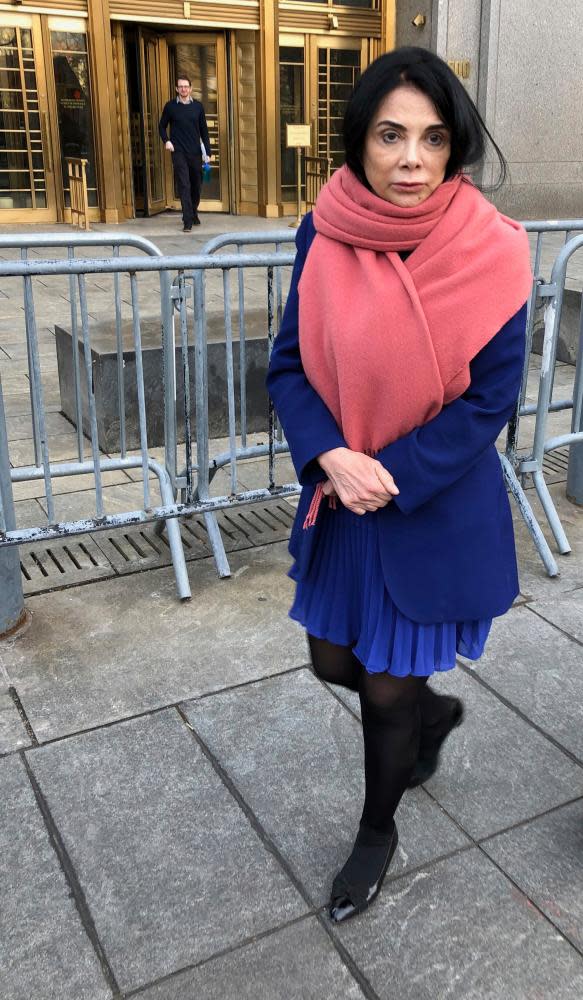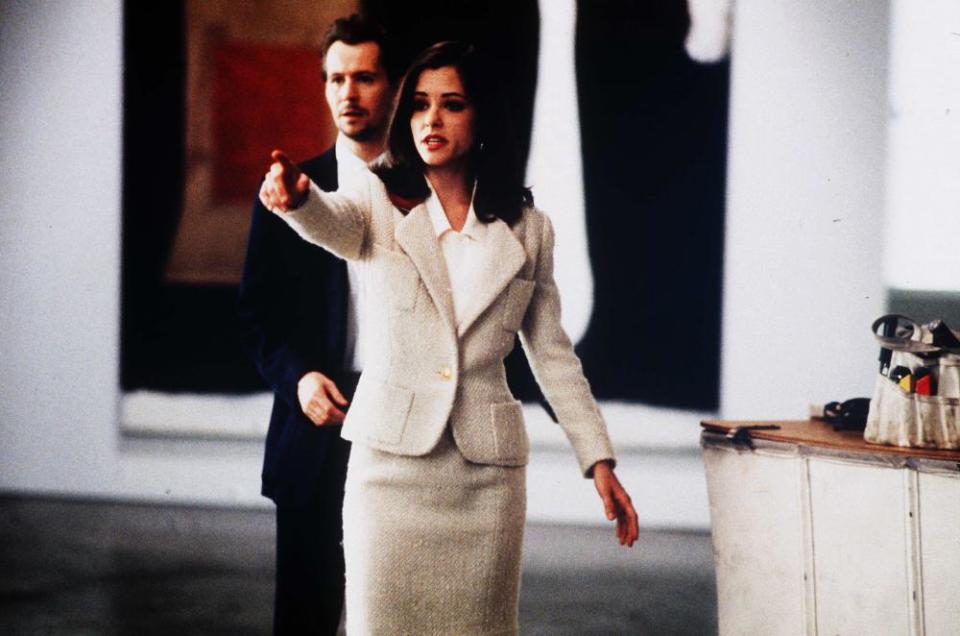'I feel like a pariah' – how art dealer Mary Boone fell from grace

Most of the art openings were a celebration during Armory week in New York, the city’s foremost art fair – but there was one that was bittersweet. The Mary Boone Gallery poured free wine for one of the last times before closing next month. Its famed gallerist will soon be sent off to federal prison for two and a half years after filing false tax returns.
It’s a jarring narrative twist for the famed New York art dealer, but she’s looking on the bright side. “Hopefully I’ll be able to come out a better person and rejoin the art world,” she told the New York Times, as her gallery is slated to close on 27 April. At her last opening reception, Boone told Bloomberg that she’s looking forward to a fresh start, “if I don’t die in prison”.
Related: How to move a masterpiece: the secret business of shipping priceless artworks
Boone, 67, pleaded guilty to evading more than $3m in taxes and has already paid back over $6m in arrears and restitution to the IRS. She claimed personal expenses, like apartment renovations and shopping sprees, as business write-offs, filing false tax returns in 2009, 2010 and 2011.
According to the Department of Justice, Boone falsely claimed a $500,000 payment to a contractor was a “commission”, when it was used to remodel one of her apartments. Boone apparently also fraudulently generated business losses, transferring $9.5m between business accounts that were apparent “tax deductible” among other crimes.
Boone’s ongoing shopping spree included cashing in on $300,000 for beauty salon visits, $15,000 on jewelry and $14,000 at Hermes.
“I stand before you saddened, humbled and heartbroken,” she said in court, adding: “I beg your honor to give me a second chance.”
To gain leniency from the judge, her lawyer, Robert S Fink, cited her struggle with mental illness, alcohol and drugs. Judge Alvin K Hellerstein reportedly retorted: “What’s the illness that causes people to steal?”
Boone apologized to the court, her colleagues and family. “I feel like a pariah,” she reportedly said. “I promise to be the best person that I can and to do good and affect lives in a positive way.”
The art world has remained quiet for the most part on Boone’s sentence, but when her gallery closes, it marks the end of an era.
“Mary has earned historical recognition as an extraordinary gallerist of the 20th century, through her tenacious work ethic and formidable visual acuity,” said art adviser Todd Levin, who has known Boone professionally since the 1980s.
She also developed expensive tastes, as the journalist Anthony Haden-Guest recalls her drinking so much champagne that her landlord complained about the mountain of bottles. New York gallerist Paula Cooper said in 1982 that Boone was “coming from nowhere and making a style”.

Mary Boone leaving court in February 2019.Photograph: Larry Neumeister/AP
It all started in 1970, when Boone moved to New York City when she was 19 years old. She grew up in a poor Egyptian household, in what she remembers as “a Middle Eastern ghetto” in Erie, Pennsylvania.
She studied art history, but excelled at working with artists. Boone was told by a colleague – Marcia Tucker, who founded the New Museum – to start her own gallery. “My art history degree basically enabled me to dust slides at the Guggenheim, which was a far cry from how I had pictured myself,” Boone told New York magazine in 1982.
Lynda Benglis, her Hunter College professor, helped Boone get hired as a secretary at Bykert Gallery. In 1977, at 26, Boone boldly came onto the New York art scene with her own namesake gallery. “I was a young woman dealer who rocked the boat,” Boone told Interview in 2014.
She saw her rise as one of the foremost women gallerists in New York upon opening her first art gallery in a former garage in the SoHo district. The 1970s was a great time for art because “the city was bankrupt, so the focus was more on the art”, Boone once said.
With her all-male cast of artists in the 1980s, Boone helped propel the careers of artist and film-maker Julian Schnabel, Guggenheim-collected artist David Salle, realist painter Eric Fischl and Jean-Michel Basquiat, famed muse of Andy Warhol. She also helped introduce the now multi-millionaire Jeff Koons to the art world, and later introduced Chinese dissident Ai Weiwei to the American market in 2008, a time before he was the celebrity he is today, as well as Kaws, who saw his rise in the street art world, long before galleries would sell his work.
She was criticized by feminists for taking on female artists such as Barbara Kruger and Sherrie Levine after they were big names. Her most recent roster includes artists such as Laurie Simmons and Angela Bulloch, among others.
Despite the shady dealings that got her behind bars, Boone has always been said to manage money in a prompt manner – she’s famous for issuing invoices the second a sale is confirmed and for quickly paying her artists, too. She apparently paid famed French philosopher Jean Baudrillard $10,000 for a catalogue essay.
In Schnabel’s 1996 biopic of Basquiat, she’s played as an uptight, money-driven businesswoman by Parker Posey but in a 2014 interview, Boone said she didn’t go into the art world for the money, claiming: “I don’t really relate to younger dealers who calibrate their success by how much money they sell something for.” Rather, to Boone, “it was about invention, discovering young artists and about discovering new talent”.

Parker Posey as Mary Boone in Basquiat.Photograph: Eleventh Street Prod/Miramax/Kobal/REX/Shutterstock
By 1982, Boone was one of the most well respected and recognized gallerists in New York. Her star-studded program and steadfast persistence as an art world fixture for almost half a century has helped change the art world.
“Mary Boone has been a terrific gallery for many years, so it’s obviously an unfortunate situation that impacts not only her, but her employees and artists, as well as the larger art world,” said John Massier, visual arts curator of Hallwalls Contemporary Art Center in Buffalo, New York. “Perhaps her unfortunate circumstance might prompt others to employ best practices and more transparency.”
As a nonviolent offender, some thought Boone would have gotten off by paying off the damage and doing community service. That wasn’t the case, however. The art world is notorious for being an unregulated industry with tax loopholes and a lack of any real rights or legal contracts.
“Your tax structure is your tax structure, we all know how to pay our taxes,” said New York gallerist Marc Wehby. “Bodega owner or a furniture store operator, we all pay.”
Boone did set the bar for gallerists to follow in her footsteps. “She pioneered what we do today, she set the mold,” said Wehby. “There was nobody bigger than her in the 1980s. But I don’t care how big you are, we gallerists are a business of small businesses. Most art galleries in New York have less than five employees. It’s a very fickle business, tastes change.”
She has always tried to discover new talent and claims to have been no more aggressive than her male counterparts in playing matchmaker for hot young artists and art collectors. Her instinct is what helped Boone make art history, an institution in her own right.
Despite her said love of art, money might have taken over. She admits to becoming “lost” in the 1980s when she was swept up by the fame and fortune of being a young gallerist who was deemed “queen of the New York art scene”, then later got caught selling actor Alec Baldwin a replica of an artwork that he wanted (she later wrote him a cheque to settle the score).
Despite her ups and downs in the business of selling art, this case was relatively straightforward. “I felt this to be an unfortunate case of simple avarice,” said Levin. “It was a persistent malicious avoidance of paying taxes, strung out over a period of years. It wasn’t a onetime thing. This was consistent.”
Some are hoping Boone will bounce back like celebrity chef turned white collar criminal Martha Stewart did, including Boone herself.
“I had 49 wonderful years in art,” Boone told ARTnews. “If I’m going to be the Martha Stewart of the art world, I would hope to do it with the same humility, humor, grace and intelligence that she did. I’m trying to be optimistic and see this as a learning experience.”

 Yahoo News
Yahoo News 